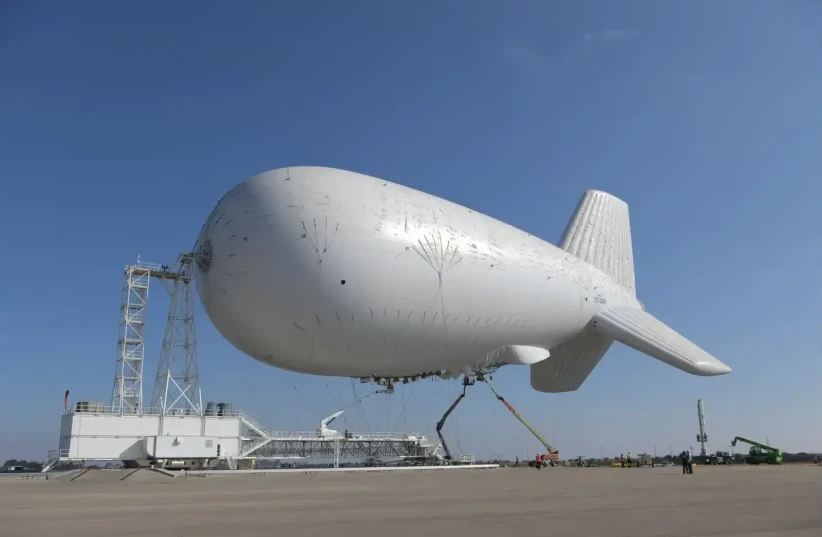Description

Disclaimer: Copyright infringement not intended.
Context
Israel deploys radar blimp along Lebanese border as tensions with Hezbollah escalate. Known as 'Sky Dew,' the blimp is a collaborative project between the US and Israel. It is designed to detect unmanned aircraft and cruise missiles from Iran and Syria.
Details
Key Features of the Sky Dew Radar Blimp
- Collaborative Project: Developed jointly by Israel Aerospace Industries (IAI), American balloon manufacturer TCOM, and supported by the Israeli Defense Ministry and the US Department of Defense.
- Purpose: Specifically designed to monitor the Israel-Lebanon border, detecting potential threats from unmanned aircraft and cruise missiles originating from Iran and Syria, particularly those that are small and challenging to detect using conventional means.
- Technology and Capabilities:
- Utilizes radar technology based on the Arrow system, capable of observing up to 250 km and simultaneously tracking multiple targets, including low-altitude and valley-based objects.
- Offers significant surveillance advantages due to its prolonged operational capabilities without the need for frequent refueling or crew replacement.
- Operates at an altitude of around 10,000 feet and can carry up to 7,000 pounds of equipment.
- Cost Efficiency: Compared to traditional surveillance aircraft like AWACS, the operational costs of the Sky Dew radar blimp are significantly lower, making it a cost-effective option for extended surveillance missions.
- Challenges and Readiness: Despite its advantages, the system faced challenges during its operationalization, highlighting issues related to readiness within the Israel Defense Forces (IDF). The blimp's size makes it vulnerable to potential enemies, and basic faults such as air leaks could affect its performance.
- Strategic Importance: Enhances Israel's surveillance capabilities significantly, providing an additional layer of defense against potential threats along the border. Its deployment signifies a strategic move to strengthen monitoring efforts and readiness in response to escalating tensions with Hezbollah.

Comparative Analysis:
- AWACS vs. Radar Blimp: While Israel couldn't purchase expensive Airborne Warning and Control System (AWACS) radar-carrying aircraft from the US, the Sky Dew blimp offers advantages in cost efficiency and extended surveillance compared to traditional radar aircraft like the Hawkeye and Nachshon.
- Operational Advantages: The blimp's ability to remain aloft for extended periods without requiring frequent fueling or crew replacement makes it a valuable asset for continuous surveillance operations.
About Radar blimp
- A radar blimp, also known as an aerostat or tethered balloon, is a specialized platform that carries radar equipment for various purposes, such as surveillance, reconnaissance, and monitoring.
- These blimps are anchored to the ground via a tether and can be deployed for extended periods, offering persistent aerial coverage.
Design and Structure:
- Radar blimps are typically large, helium-filled balloons tethered to the ground.
- They can vary in size, from smaller observation balloons to larger aerostats capable of carrying heavier radar systems.
- The balloon's envelope is often made of durable materials like synthetic fabrics to withstand weather conditions.
- The radar equipment is installed either inside the balloon or suspended beneath it.
Functionality:
- Radar blimps are equipped with radar systems that can detect and track various targets, including aircraft, ships, vehicles, and even individuals.
- They provide a wide-area surveillance capability, monitoring activities over large regions.
- These systems can be employed for military, border security, maritime surveillance, and disaster response purposes.
Advantages:
- Offers persistent surveillance: Unlike conventional aircraft, radar blimps can stay aloft for extended periods, providing continuous coverage.
- Cost-effective: They can cover large areas at a fraction of the cost of maintaining aircraft on patrol.
- Flexibility: Radar blimps can be deployed in remote or inaccessible areas, enhancing surveillance capabilities.
Applications:
- Military: Used for border security, monitoring airspace, detecting and tracking hostile threats, and supporting military operations.
- Civilian: Used for border control, disaster management, monitoring illegal activities like smuggling, and supporting law enforcement efforts.
Types of Radar Blimps:
- Tactical Aerostats: Smaller, more mobile aerostats used in military operations for battlefield surveillance and target acquisition.
- Persistent Surveillance Aerostats: Larger blimps used for long-term monitoring and surveillance, often employed for border security or coastal surveillance.
- Customized Payloads: Some blimps can carry various payloads beyond radar, including cameras, communication equipment, and other sensors, enhancing their versatility.
Challenges:
- Weather Conditions: Strong winds, storms, and adverse weather conditions can affect the stability and operation of radar blimps.
- Vulnerability: Being tethered makes them vulnerable to potential threats, and they may require security measures to prevent tampering or attacks.
- Maintenance: Regular maintenance and helium refills are necessary for prolonged operations.

About Radar
- Radar (Radio Detection and Ranging) technology is a system that uses radio waves to detect, locate, track, and identify objects such as aircraft, ships, vehicles, weather formations, and more.
Principle of Operation:
- Radar operates on the principle of sending out radio waves and detecting the reflections (echoes) from objects in the path of these waves.
- A radar system typically consists of a transmitter, antenna, receiver, and signal processor.
- The transmitter emits short pulses of electromagnetic energy (radio waves) via the antenna.
- When these waves encounter objects, they reflect back towards the radar system.
- The receiver detects the returning signals, which are then processed to determine the object's distance, speed, direction, and other characteristics.
Key Components:
- Transmitter: Generates electromagnetic waves at a specific frequency.
- Antenna: Emits and receives radio waves. Its design affects radar performance, such as beam width and directivity.
- Receiver: Captures and amplifies the returned signals for processing.
- Signal Processor: Analyzes the received signals to extract information about the detected objects.
Radar Functions:
- Detection: Radar systems can identify the presence of objects within their range by analyzing the reflected signals.
- Range Determination: By measuring the time taken for the signal to return, radar calculates the distance to the detected object.
- Doppler Effect: Radar can determine an object's speed by analyzing the frequency shift (Doppler shift) of the returned signal caused by the motion of the object.
- Tracking: Advanced radar systems can track the movement of objects over time, providing information about their trajectory, speed changes, and more.
- Imaging: Some radar systems can create images or maps based on the reflections received, offering detailed visual information about the scanned area or objects.
Types of Radar:
- Pulse Radar: Emits short pulses of radio waves and detects the echoes. It's commonly used for range measurement and target detection.
- Continuous Wave (CW) Radar: Uses continuous transmission and reception of signals. It's often employed for applications like speed measurement (Doppler radar) or in radar altimeters.
- Phased Array Radar: Utilizes multiple small antennas to steer the radar beam electronically, allowing for rapid beam scanning and target tracking.
- Synthetic Aperture Radar (SAR): Provides high-resolution images by processing reflections from multiple radar pulses as the system moves.
Applications:
- Aviation: Radar assists in aircraft navigation, air traffic control, collision avoidance, weather detection, and landing assistance.
- Maritime: Used for ship navigation, collision avoidance, and monitoring marine traffic.
- Military: Radar has critical military applications, including surveillance, target detection, missile guidance, and battlefield awareness.
- Weather Forecasting: Weather radar systems track precipitation, storm movements, and atmospheric conditions, aiding in weather forecasting and monitoring severe weather events.
- Automotive: Radar technology is employed in vehicles for adaptive cruise control, collision avoidance systems, and parking assistance.
Challenges and Advances:
- Resolution and Accuracy: Advancements focus on improving radar resolution and accuracy for better target identification and tracking.
- Signal Processing: Developments in signal processing technologies enhance the ability to extract useful information from radar returns.
- Stealth Technology: Radar systems face challenges in detecting stealthy objects designed to minimize their radar signature.
- Integration: Radar technology is increasingly integrated with other sensor systems like lidar and cameras for enhanced sensing capabilities.
Conclusion
The deployment of the Sky Dew radar blimp represents a significant advancement in Israel's surveillance capabilities along the Lebanon border. Despite challenges faced during its operationalization, the blimp's advanced radar technology and cost-efficient extended surveillance capabilities offer a substantial advantage in monitoring potential threats from Iran, Syria, and Hezbollah-controlled regions.
|
PRACTICE QUESTION
Q. Radar technology plays a pivotal role in modern defense and civilian applications. Discuss the underlying principles of radar operation, its diverse applications, recent advancements, and the challenges faced in its utilization. (250 Words)
|











